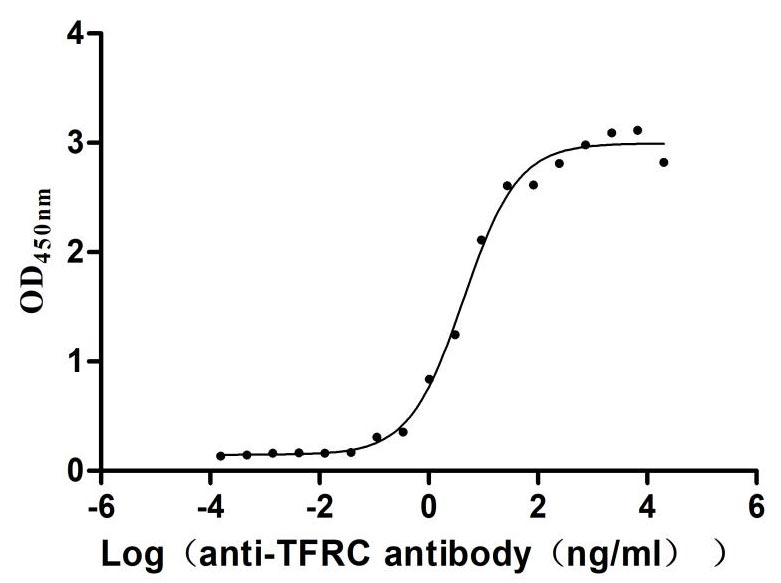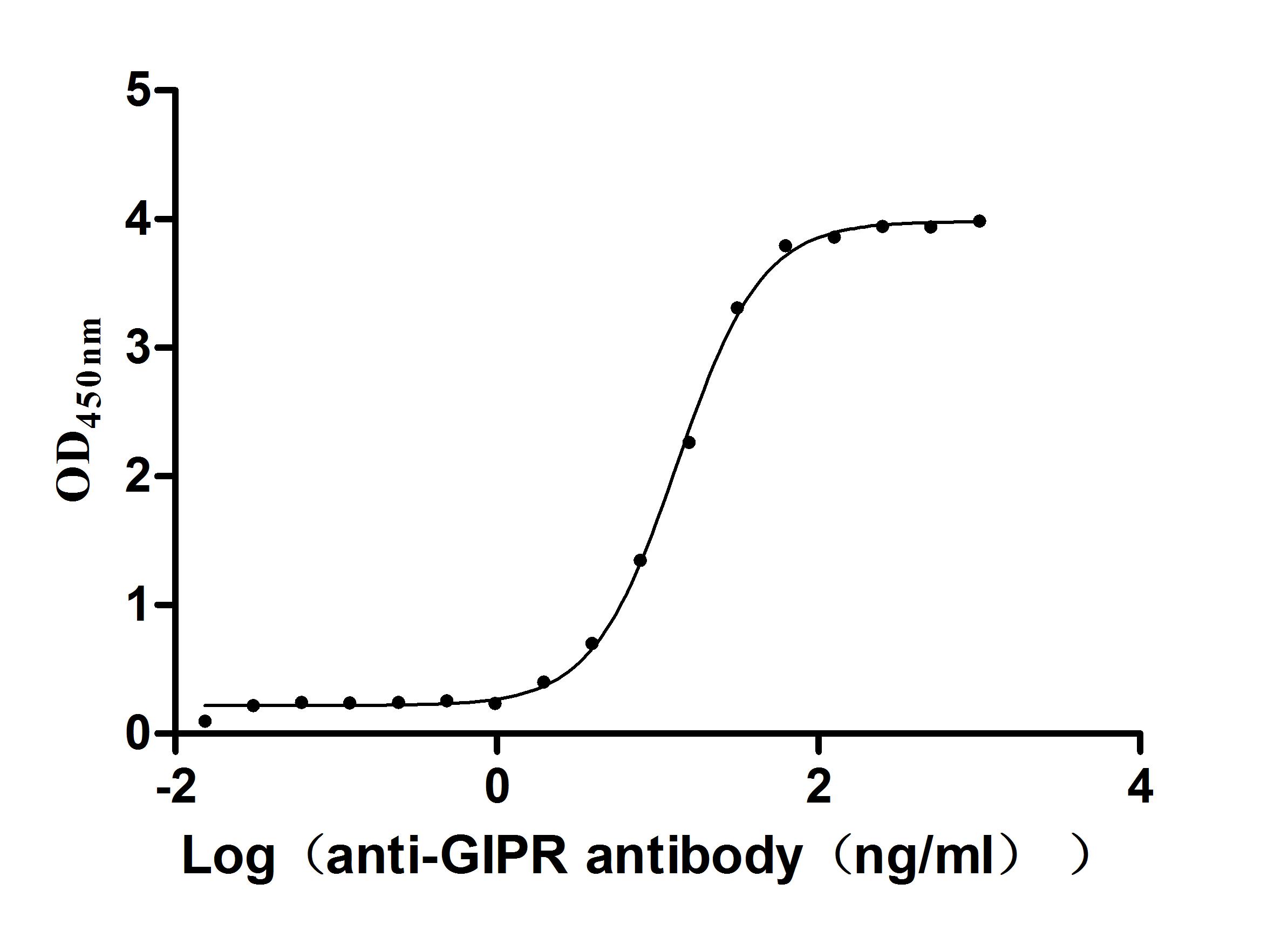Recombinant Zika virus Genome polyprotein, partial
-
中文名称:
-
货号:CSB-EP3643GOZ3
-
规格:¥2328
-
图片:
-
其他:
产品详情
-
纯度:Greater than 85% as determined by SDS-PAGE.
-
基因名:N/A
-
Uniprot No.:
-
种属:Zika virus (ZIKV)
-
蛋白长度:Partial
-
来源:E.coli
-
分子量:28.2 kDa
-
表达区域:1415-1463aa+GGGGSGGGG+1499-1668aa
-
氨基酸序列KSVDMYIERAGDITWEKDAEVTGNSPRLDVALDESGDFSLVEEDGPPMRGGGGSGGGGSGALWDVPAPKEVKKGETTDGVYRVMTRRLLGSTQVGVGVMQEGVFHTMWHVTKGAALRSGEGRLDPYWGDVKQDLVSYCGPWKLDAAWDGLSEVQLLAVPPGERARNIQTLPGIFKTKDGDIGAVALDYPAGTSGSPILDKCGRVIGLYGNGVVIKNGSYVSAITQGKR
Note: The complete sequence including tag sequence, target protein sequence and linker sequence could be provided upon request. -
蛋白标签:N-terminal 6xHis-tagged
-
产品提供形式:Liquid or Lyophilized powder
Note: We will preferentially ship the format that we have in stock, however, if you have any special requirement for the format, please remark your requirement when placing the order, we will prepare according to your demand. -
缓冲液:If the delivery form is liquid, the default storage buffer is Tris/PBS-based buffer, 5%-50% glycerol. If the delivery form is lyophilized powder, the buffer before lyophilization is Tris/PBS-based buffer, 6% Trehalose.
-
复溶:We recommend that this vial be briefly centrifuged prior to opening to bring the contents to the bottom. Please reconstitute protein in deionized sterile water to a concentration of 0.1-1.0 mg/mL.We recommend to add 5-50% of glycerol (final concentration) and aliquot for long-term storage at -20°C/-80°C. Our default final concentration of glycerol is 50%. Customers could use it as reference.
-
储存条件:Store at -20°C/-80°C upon receipt, aliquoting is necessary for mutiple use. Avoid repeated freeze-thaw cycles.
-
保质期:The shelf life is related to many factors, storage state, buffer ingredients, storage temperature and the stability of the protein itself.
Generally, the shelf life of liquid form is 6 months at -20°C/-80°C. The shelf life of lyophilized form is 12 months at -20°C/-80°C. -
货期:13-23 business days
-
注意事项:Repeated freezing and thawing is not recommended. Store working aliquots at 4°C for up to one week.
-
Datasheet & COA:Please contact us to get it.
靶点详情
-
功能:Plays a role in virus budding by binding to the host cell membrane and packages the viral RNA into a nucleocapsid that forms the core of the mature virus particle. During virus entry, may induce genome penetration into the host cytoplasm after hemifusion induced by the surface proteins. Can migrate to the cell nucleus where it modulates host functions.; Inhibits RNA silencing by interfering with host Dicer.; Prevents premature fusion activity of envelope proteins in trans-Golgi by binding to envelope protein E at pH 6.0. After virion release in extracellular space, gets dissociated from E dimers.; Plays a role in host immune defense modulation and protection of envelope protein E during virion synthesis. PrM-E cleavage is inefficient, many virions are only partially matured and immature prM-E proteins could play a role in immune evasion. Contributes to fetal microcephaly in humans. Acts as a chaperone for envelope protein E during intracellular virion assembly by masking and inactivating envelope protein E fusion peptide. prM is the only viral peptide matured by host furin in the trans-Golgi network probably to avoid catastrophic activation of the viral fusion activity in acidic Golgi compartment prior to virion release.; May play a role in virus budding. Exerts cytotoxic effects by activating a mitochondrial apoptotic pathway through M ectodomain. May display a viroporin activity.; Binds to host cell surface receptors and mediates fusion between viral and cellular membranes. Efficient virus attachment to cell is, at least in part, mediated by host HAVCR1 in a cell-type specific manner. In addition, host NCAM1 can also be used as entry receptor. Interaction with host HSPA5 plays an important role in the early stages of infection as well. Envelope protein is synthesized in the endoplasmic reticulum and forms a heterodimer with protein prM. The heterodimer plays a role in virion budding in the ER, and the newly formed immature particle is covered with 60 spikes composed of heterodimers between precursor prM and envelope protein E. The virion is transported to the Golgi apparatus where the low pH causes the dissociation of PrM-E heterodimers and formation of E homodimers. PrM-E cleavage is inefficient, many virions are only partially matured and immature prM-E proteins could play a role in immune evasion.; Plays a role in the inhibition of host RLR-induced interferon-beta activation by targeting TANK-binding kinase 1/TBK1. In addition, recruits the host deubiquitinase USP8 to cleave 'Lys-11'-linked polyubiquitin chains from caspase-1/CASP1 thus inhibiting its proteasomal degradation. In turn, stabilized CASP1 promotes cleavage of cGAS, which inhibits its ability to recognize mitochondrial DNA release and initiate type I interferon signaling.; Component of the viral RNA replication complex that recruits genomic RNA, the structural protein prM/E complex, and the NS2B/NS3 protease complex to the virion assembly site and orchestrates virus morphogenesis. Antagonizes also the host MDA5-mediated induction of alpha/beta interferon antiviral response. May disrupt adherens junction formation and thereby impair proliferation of radial cells in the host cortex.; Required cofactor for the serine protease function of NS3.; Displays three enzymatic activities: serine protease, NTPase and RNA helicase. NS3 serine protease, in association with NS2B, performs its autocleavage and cleaves the polyprotein at dibasic sites in the cytoplasm: C-prM, NS2A-NS2B, NS2B-NS3, NS3-NS4A, NS4A-2K and NS4B-NS5. NS3 RNA helicase binds RNA and unwinds dsRNA in the 3' to 5' direction. Leads to translation arrest when expressed ex vivo.; Regulates the ATPase activity of the NS3 helicase activity. NS4A allows NS3 helicase to conserve energy during unwinding. Cooperatively with NS4B suppresses the Akt-mTOR pathway and leads to cellular dysregulation. By inhibiting host ANKLE2 functions, may cause defects in brain development, such as microcephaly. Antagonizes also the host MDA5-mediated induction of alpha/beta interferon antiviral response. Leads to translation arrest when expressed ex vivo.; Functions as a signal peptide for NS4B and is required for the interferon antagonism activity of the latter.; Induces the formation of ER-derived membrane vesicles where the viral replication takes place. Plays also a role in the inhibition of host RLR-induced interferon-beta production at TANK-binding kinase 1/TBK1 level. Cooperatively with NS4A suppresses the Akt-mTOR pathway and leads to cellular dysregulation.; Replicates the viral (+) and (-) RNA genome, and performs the capping of genomes in the cytoplasm. Methylates viral RNA cap at guanine N-7 and ribose 2'-O positions. Once sufficient NS5 is expressed, binds to the cap-proximal structure and inhibits further translation of the viral genome. Besides its role in RNA genome replication, also prevents the establishment of a cellular antiviral state by blocking the interferon-alpha/beta (IFN-alpha/beta) signaling pathway. Mechanistically, interferes with host kinases TBK1 and IKKE upstream of interferon regulatory factor 3/IRF3 to inhibit the RIG-I pathway. Antagonizes also type I interferon signaling by targeting STAT2 for degradation by the proteasome thereby preventing activation of JAK-STAT signaling pathway. Within the host nucleus, disrupts host SUMO1 and STAT2 co-localization with PML, resulting in PML degradation. May also reduce immune responses by preventing the recruitment of the host PAF1 complex to interferon-responsive genes.
-
基因功能参考文献:
- Here, by mutagenesis, the s found a major role of the N-glycosylation of flavivirus E protein in its transmission circle, facilitating its survival against the vector immune system during invasion of the mosquito midgut while blood feeding on the host. PMID: 29463651
- In complex with an inhibitor, the protease adopts a closed, "active" conformation with the NS2B chain wrapped around the NS3(pro) and contributing to the S2 pocket.[review] PMID: 29845530
- crystal structure of the apo ZIKV NS2B-NS3pro complex in a monomeric form; structure reveals a molecular mechanism for ZIKV NS3pro inhibition and identifies a new target for rational drug design against flavivirus PMID: 27752039
- Data indicate a crystal structure at 1.84 A resolution of ZIKV non-structural protein NS2B-NS3 protease with the last four amino acids of the NS2B cofactor bound at the NS3 active site. PMID: 27845325
- The potential roles of NS2B and NS4A Zika virus proteins in its global pandemic has been reported. PMID: 29428601
- The mutation enables NS1 binding to TBK1 and reduces TBK1 phosphorylation and inhibit interferon-beta induction. PMID: 29379028
- The Zika virus envelope protein glycan loop modulates antigenicity. PMID: 29304471
- Structural docking suggests that temoporfin potentially binds NS3 pockets that hold critical NS2B residues, thus inhibiting flaviviral polyprotein processing in a non-competitive manner. PMID: 28685770
- Sustained Specific and Cross-Reactive T Cell Responses to Zika and Dengue Virus NS3 in West Africa PMID: 29321308
- Based on the proposition that the Zika virus NS5 protein utilizes SIAH2-mediated proteasomal degradation of STAT2, an in-silico study was carried out to characterize the protein-protein interactions between NS5, SIAH2 and STAT2 proteins. PMID: 28365387
- As the NS2B co-factor is involved in substrate binding of flaviviral NS2B-NS3 proteases, the destabilization of the closed conformation in the linked construct makes it an attractive tool to search for inhibitors that interfere with the formation of the enzymatically active, closed conformation. PMID: 28336347
- Here, we solved the crystal structure of full-length NS1 protein, and found an extended membrane association interface contributed by the hydrophobic "spike" of a long intertwined loop, providing important information for ZIKV pathogenesis and development of diagnostic tools. PMID: 27578809
- When Zika virus NS5 was expressed, the formation of STAT1-STAT1 homodimers and their recruitment to IFN-gamma-stimulated genes, such as the gene encoding the proinflammatory cytokine CXCL10, were augmented. PMID: 28468880
- NS4A and NS4B, cooperatively suppress the Akt-mTOR pathway and lead to cellular dysregulation. PMID: 27524440
- The immature ZIKV contains a partially ordered capsid protein shell that is less prominent in other immature flaviviruses. PMID: 28067914
- The crystal structure of a C-terminal fragment of ZIKV nonstructural protein 1 (NS1), a major host-interaction molecule that functions in flaviviral replication, pathogenesis and immune evasion. PMID: 27088990
- the crystal structure of full-length Zika virus NS1 PMID: 27455458
- Study present the crystal structures of ZIKV NS5 N-terminal methyltransferase in complex with an RNA cap analogue ((m7)GpppA) and the free NS5 C-terminal RNA-dependent RNA polymerase. PMID: 28254839
- A high-resolution (1.62-A) crystal structure of the RNA helicase from the French Polynesia strain of Zika virus. PMID: 27399257
- The structure of ZIKV helicase-RNA has revealed that upon RNA binding, rotations of the motor domains can cause significant conformational changes. Strikingly, although ZIKV and dengue virus (DENV) apo-helicases share conserved residues for RNA binding, their different manners of motor domain rotations result in distinct individual modes for RNA recognition. PMID: 27430951
显示更多
收起更多
-
亚细胞定位:[Capsid protein C]: Virion. Host nucleus. Host cytoplasm. Host cytoplasm, host perinuclear region.; [Peptide pr]: Secreted.; [Small envelope protein M]: Virion membrane; Multi-pass membrane protein. Host endoplasmic reticulum membrane; Multi-pass membrane protein.; [Envelope protein E]: Virion membrane; Multi-pass membrane protein. Host endoplasmic reticulum membrane; Multi-pass membrane protein.; [Non-structural protein 1]: Secreted. Host endoplasmic reticulum membrane; Peripheral membrane protein; Lumenal side.; [Non-structural protein 2A]: Host endoplasmic reticulum membrane; Multi-pass membrane protein.; [Serine protease subunit NS2B]: Host endoplasmic reticulum membrane; Multi-pass membrane protein.; [Serine protease NS3]: Host cytoplasm. Host endoplasmic reticulum membrane; Peripheral membrane protein; Cytoplasmic side.; [Non-structural protein 4A]: Host endoplasmic reticulum membrane; Multi-pass membrane protein.; [Non-structural protein 4B]: Host endoplasmic reticulum membrane; Multi-pass membrane protein.; [RNA-directed RNA polymerase NS5]: Host endoplasmic reticulum membrane; Peripheral membrane protein; Cytoplasmic side. Host nucleus.
-
数据库链接:
KEGG: vg:7751225
Most popular with customers
-
Recombinant Human Cannabinoid receptor 1 (CNR1)-VLPs (Active)
Express system: Mammalian cell
Species: Homo sapiens (Human)
-
Recombinant Human Microtubule-associated protein tau (MAPT) (Active)
Express system: Mammalian cell
Species: Homo sapiens (Human)
-
Recombinant Human Desmoglein-2 (DSG2), partial (Active)
Express system: Mammalian cell
Species: Homo sapiens (Human)
-
Recombinant Human Transferrin receptor protein 1 (TFRC), partial (Active)
Express system: Mammalian cell
Species: Homo sapiens (Human)
-
Recombinant Human Killer cell immunoglobulin-like receptor 3DL2 (KIR3DL2), partial (Active)
Express system: Mammalian cell
Species: Homo sapiens (Human)
-
Recombinant Macaca fascicularis C-type lectin domain family 4 member C(CLEC4C), partial (Active)
Express system: Mammalian cell
Species: Macaca fascicularis (Crab-eating macaque) (Cynomolgus monkey)
-
Recombinant Macaca fascicularis Gastric inhibitory polypeptide receptor (GIPR), partial (Active)
Express system: yeast
Species: Macaca fascicularis (Crab-eating macaque) (Cynomolgus monkey)
-
Recombinant Human Cadherin-6(CDH6),partial (Active)
Express system: Mammalian cell
Species: Homo sapiens (Human)




-AC1.jpg)
















